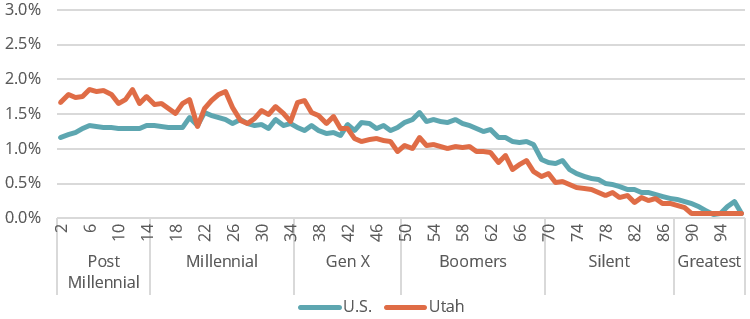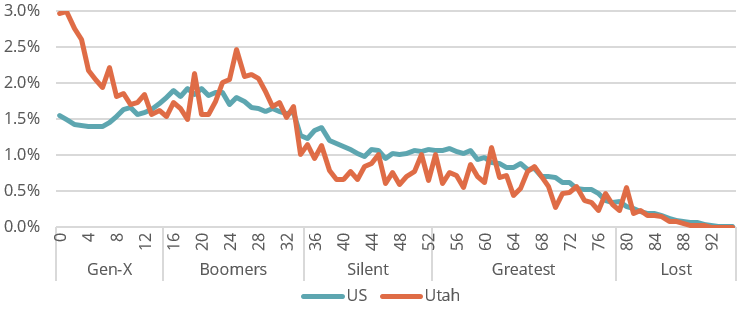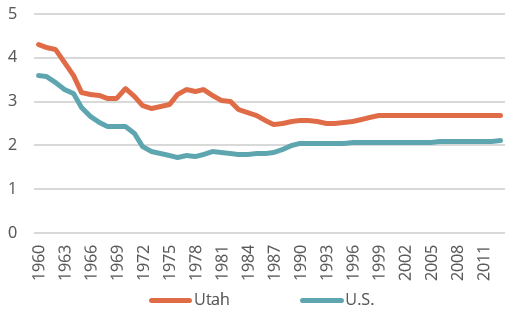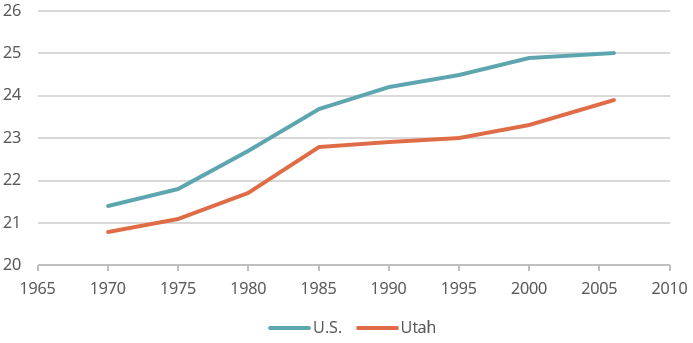It is only this year that the national Millennial Generation overtook the Baby Boom Generation. Yet in Utah, the Millennial Generation was larger than the Baby Boom Generation more than 15 years ago. Why is Utah’s boomer population so small? Was Utah even part of the Baby Boom?
Figure 1: Proportion of Utah and U.S. Generations, 2015
| Generation | Ages | Utah | National |
| Post Millennial | 0-14 | 23% | 17% |
| Millennial | 15-34 | 31% | 27% |
| Gen-X | 35-49 | 20% | 19% |
| Boomer | 50-69 | 19% | 25% |
| Silent | 70-87 | 7% | 10% |
| Greatest | 88+ | 1% | 2% |
Source: U.S. Census
Figures 1 and 2 compare the age distribution of the United States to Utah. Utah is the youngest state in the country and Figure 2 illustrates how Utah has a larger proportion of its population under the age of 42 and a smaller proportion of its population over 42. At the national level, you can see the slight bump over the boomer years, but no such bump can be seen in Utah.
Figure 2: Age Distribution Percentages in 2015
Source: U.S. Census
What did this graph look like decades ago? Did the Boomers in Utah ever actually boom?
Figure 3: Age Distribution Percentages in 1980
Source: IPUMS
Figure 4: Proportion of Utah and U.S. Generations, 1980
| Generation | Ages | Utah | National |
| Gen-X | 0-14 | 32% | 23% |
| Boomer | 15-34 | 36% | 35% |
| Silent | 35-52 | 15% | 20% |
| Greatest | 53-78 | 16% | 20% |
| Lost | 79+ | 2% | 2% |
Source: IPUMS
Looking back to 1980, there is a definite increase between the Silent and Baby Boom generations (age 34 in Figure 3), and the Boomer Generation is undoubted the largest segment of the population (see Figure 4). The main difference is that the national boom trailed off around 1965 (age 15 in Figure 3), but Utah’s seemingly picked up speed. To explain that, we turn to fertility rates and age of the mother at first birth.
Most generational studies have the Baby Boom ending around 1965, which is quite clear in Figure 5. While Utah dropped from the peak of the Boomer years, it was nearly double (88%) the national fertility rate from 1976-1980 (the tail end of Gen-X).
Figure 5: Total Fertility Rates (live births per 1,000)
Source: Pam Perlich, DemographyUTAH
Moreover, not only were Utah women having more children, but Utah women were having them earlier too (see Figure 6).
Figure 6: Age of Mother at First Birth
Source: Pam Perlich, DemographyUTAH
This has resulted in a blurring of generations in Utah. One of the alternate names for the Millennial Generation is the “Echo Boomer Generation.” In Utah, this echo boom happened earlier, on the transitory zone of Gen-Xers and Millennials. So why is Utah’s Millennial generation so much larger than the national Millennial generation? It is because of that consistently higher birth rate which continues to lower the share of the population occupied by the Baby Boomers.
In addition, there was a time of out-migration from Utah between 1984-1990. Although we have little data to support the idea, it is possible that many of those who left were Boomers. They would have been emerging adults at that time and the economic recession and sectoral shifts of this time period could have pushed these younger individuals with younger families out of the state to seek better economic opportunities elsewhere.
But in the end, it wasn’t that Utah didn’t have a boom, but rather Utah had an extended boom and consistently higher birth rates than the nation. This left younger generations as a substantially larger portion of the population than their national counterparts.
Categories:





